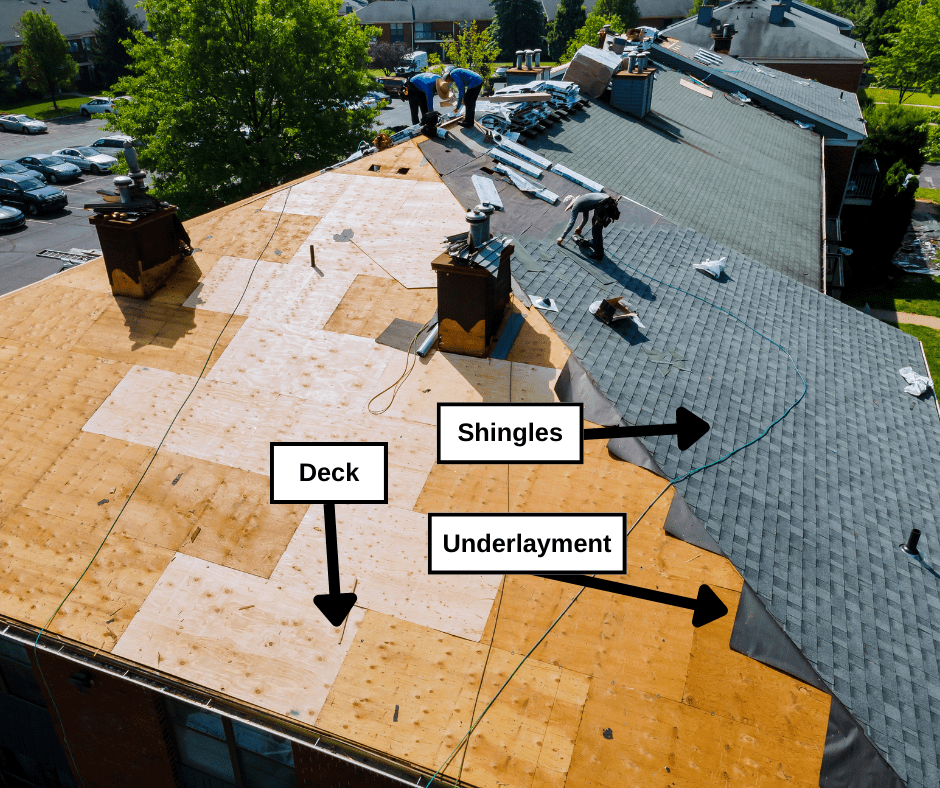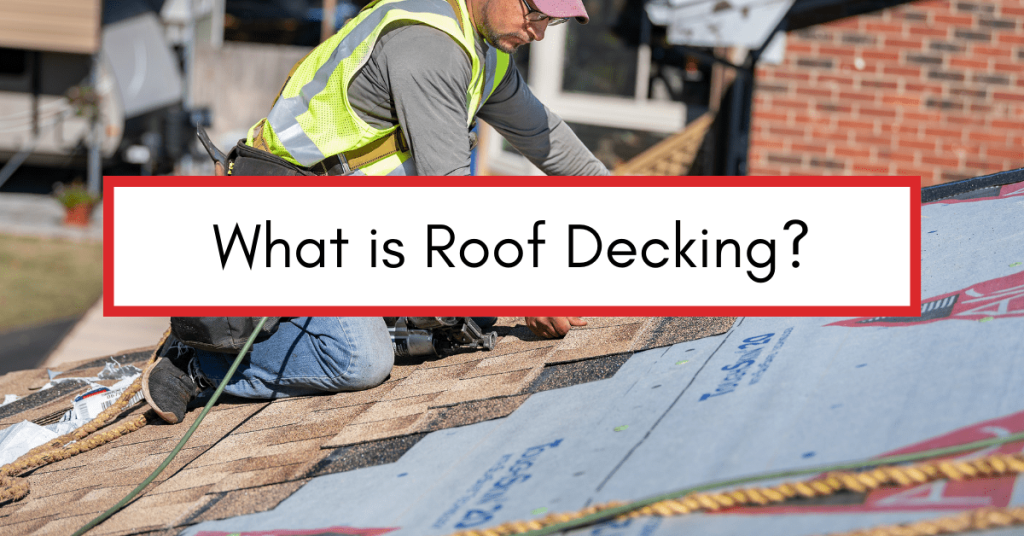When it comes to protecting your home from the elements, a sturdy and dependable roof is essential. While the roofing materials that are visible may garner much of the attention, a roofing component not well-known by homeowners serves as the foundation of a strong roofing system: roof decking.
Perhaps, you’ve been told while getting roof replacement bids that your roof decking needs to be replaced. Or maybe you’re starting to notice some of the symptoms of a shoddy roof deck.
Regardless, we want to help you understand what your roof deck is, why it’s so important and what to look for in terms of replacement.
In this article, we will explore what roof decking is, its importance in maintaining a secure and durable roof, and why homeowners should pay attention to this crucial but unseen element. By understanding the significance of roof decking, you can ensure the long-term integrity and performance of your entire roofing system.
Roof Decking: The Foundation of Your Roof
Roof decking, also called OSB sheathing, sits directly on top of your roof’s structural supports, like trusses or rafters. It provides a stable base for roofing materials and serves several critical functions:
Structural Support: Roof decking distributes the weight of roofing materials, such as shingles or tiles, evenly across the framework. This prevents excessive stress on the underlying structure.
Stability and Rigidity: Fastening the decking securely adds stability to the entire roof system. It helps the roof resist wind, impact, and other external forces.
Moisture Protection: Roof decking acts as a secondary barrier against moisture. Proper installation helps prevent water from causing rot, mold, or insulation damage.
Base for Roofing Materials: A smooth, even surface allows for proper alignment, secure attachment, and optimal performance of roofing materials.
Homeowners often discover they need roof decking replacement when collecting bids for a roof replacement. Age and multiple previous roof replacements are the most common reasons.
Every roof replacement drives 115 to 175 nail holes per 4×8 sheet of plywood or OSB sheathing. Homes built between the 1960s and 1980s may have 300 to 500 nail holes per sheet. Over time, this decking becomes too damaged to support new nails. At that point, the wood can resemble Swiss cheese more than solid sheathing. Replacing it ensures your new roof has a strong, reliable foundation.

If your roof deck sustains damage from a weather event or from a leak, this may cause enough damage that certain areas need to be replaced.
Consequences of Ignoring Your Roof Decking
The consequences to not replacing your roof decking can be drastic. If your trusted roofing contractor suggests that it’s time to replace your decking, do not put it off. Getting opinions and bids from other roofing contractors is always a good practice and helps you feel confident you’re getting a fair assessment and price.
If you choose to not replace your decking when it’s needed, some consequences include:
· Sagging or Uneven Roof Surface: A common sign of a failing roof deck is visual sagging or waviness when looking at your roofline. If you replace your roof without replacing your roof deck, your roof will sag in between your trusses or rafters, causing a noticeable and worrisome appearance.
· Water Stains or Mold Growth: Damaged decking allows moisture to penetrate the underlying layers, leading to rot, mold growth, and water damage within the attic and interior spaces of the home. Water damage and mold growth can cost thousands to repair and remediate.
· Excessive Shingle Wear and Tear: A faulty roof deck will take its toll on your shingles. If your roof deck is compromised enough, your shingles can easily be blown off by strong winds or weather.
· Compromised Structural Integrity: Over time, weakened roof decking can compromise the stability and load-bearing capacity of the entire roofing system, potentially leading to sagging or even collapse.
· Decreased Energy Efficiency: Defective roof decking can result in air leaks, compromising the energy efficiency of the home and leading to increased heating and cooling costs.
If your roof deck needs to be replaced, do not put it off. Your roof deck plays an extremely important role in protecting your home and sustaining its structural integrity.
Types of Roof Decking Materials & Associated Cost
In Central Kentucky, common types of decking materials include:
· Plywood: Often made of multiple layers of thin wood veneers glued together, plywood provides strength, durability, and resistance to moisture. Plywood with a minimum thickness of 5/8 inch is recommended for decking on homes in Kentucky.
· Oriented Strand Board (OSB) Sheathing: OSB is composed of wood strands that are compressed and bonded with adhesive resins. It offers similar strength and durability to plywood and is a cost-effective option.
Your overall cost for replacing your roof deck will depend on the material used, the price of the material (plywood costs can fluctuate greatly), and how much needs to be replaced.
Lifespan and Replacement Frequency for Roof Decking
The lifespan of roof decking can vary depending on factors such as the quality of the material, climate conditions, and proper maintenance. Here in Kentucky, where extreme weather events and temperature fluctuations occur, it is advisable to inspect the decking periodically. On average, decking may last for two or even three roof replacements. However, factors like moisture damage, insect infestations, or inadequate ventilation can shorten its lifespan.
Does Your Home Need New Roof Decking?
Roof decking is a fundamental component of a sturdy and reliable roofing system. Acting as the foundation for your roof, it provides structural support and evenly distributes the weight of the roofing materials.
Decking is just one of the pieces that make up your entire roofing system. We created our Learning Center and YouTube channel to help homeowners feel knowledgeable about each part of their roof and help answer important questions about the roofing process.
In order to make sure you’re getting a great price on your roof replacement, we also recommend getting multiple bids from top rated roofing companies in the Central Kentucky area. In our Learning Center, we outline tips on how to select a reliable contractor and make an apples-to-apples comparison across your roofing bids.
AIC Roofing & Construction has replaced over 10,000 roofs in the Lexington, Louisville and Richmond, KY areas. We are in the top 2% of roofing contractors in North America that received the GAF Master Elite Certification. Working with a GAF Master Elite certified contractor should give you peace of mind that you’re working with an experienced roofer that has undergone rigorous training. Along with our GAF Master Elite certification is an extended material and craftsmanship warranty. We renew this certification every year as part of our commitment to excellence. If you’re preparing for a roof replacement or would like a second opinion – only trust your home to the best. Contact us today for a free estimate on your roof.
Default insurance Lexington Louisville Richmond roof replacement
